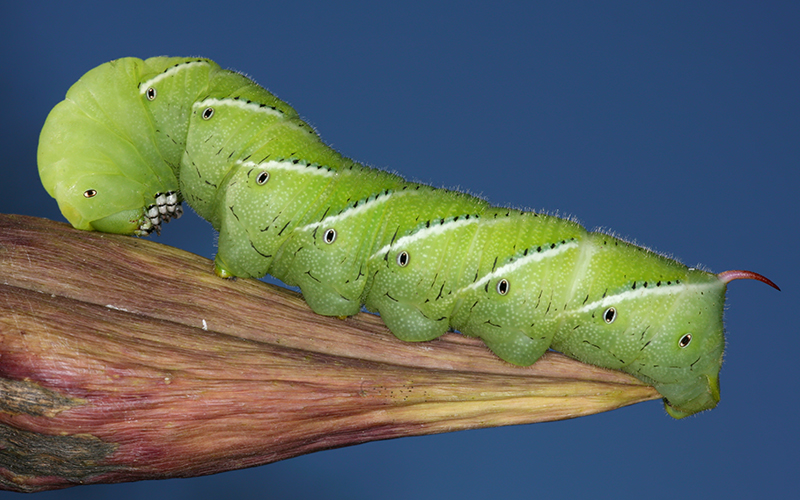By Nadie VanZandt,
Extension Master Gardener Intern
University of Vermont
This time of year I get impatient for the long-awaited harvest of my tomatoes and the taste of their sweet, homegrown flavor. But will I get to them before the arrival of the dreaded hornworms?
These sizable pests come like thieves in the night and can ravage a plant in a surprisingly short time span. They are remarkably fleshy, large and striking green caterpillars that can reach 3 to 4 inches in length and grow as wide as a thumb. If you are like me, an encounter with one may make you squeamish.
Hornworms feed on plants in the nightshade family including tomatoes, potatoes, peppers and eggplants. Two closely-related cousins are common in the home garden, the tomato hornworm (Manduca quinquemaculata) and the tobacco hornworm (Manduca sexta).
Each can be easily recognized by their markings. The tomato hornworm has white V-shaped stripes on its body and a prominent black horn-like protrusion on the end of its abdomen.
The more common tobacco hornworm features diagonal white stripes and a reddish "horn." Its bright green color camouflages it in the foliage and stems, making it possible for it to "hide" in plain sight.
These caterpillars are the larvae that hatch from the eggs of large nocturnal moths in the Sphingidae family, commonly called hummingbird, sphinx or hawk moths. Hornworms typically appear when plants have abundant fruit production. They can decimate your plants overnight if not caught early.
Since these pests are so well camouflaged and hide during the day, look for them under leaves and along stems with a keen eye. They usually feed from dawn to dusk beginning at the top of the plant.
Tell-tale signs of their presence are stems stripped of leaves, gouged fruit and grenade-like black droppings known as frass. Look straight up from the droppings to find the culprit. Be vigilant and do this several times a week if not daily.
Fortunately, following integrated pest management (IPM) practices such as handpicking in early morning and evening has proven to be an effective solution. These fleshy hornworms have strong legs, so you'll need a firm grip. Pick them off -- this may take a little grit -- and drop them in a jar of soapy water.
Another IPM strategy is to encourage predatory insects to visit your garden. The herbs, nectar-producing plants and flowers blooming in your garden will prove valuable for this purpose. Lacewings and ladybugs will prey on eggs and young hornworms. Paper wasps mostly feed on caterpillars including hornworms.
In addition, the braconid wasp (Cotesia congregata), which lays eggs on the body of hornworms, is a welcome ally. The wasp's larvae feed on the hornworm making it look like a sushi roll. If left alone, the wasps will emerge, kill the worm and then seek out their next victim.
Finally, keeping your garden tidy and weed free will discourage the adult moth by reducing potential sites for it to lay its eggs. At the end of the season after harvest, till the soil to get rid of burrowing hornworms and pupae. And, as always, get in the habit of rotating your crops.
For more information on hornworms, visit undefined.






